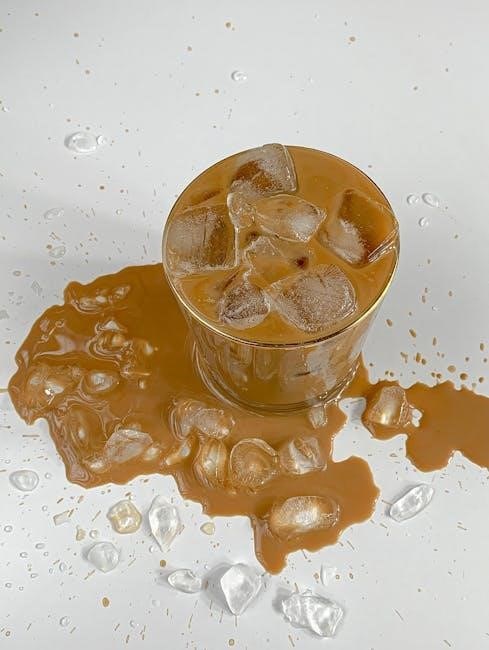cold brew coffee maker instructions
- Published
- in Instructions
Cold brew coffee has gained popularity for its smooth, low-acidity flavor. This guide provides easy step-by-step instructions to brew perfect cold coffee at home using a coffee maker.
What is Cold Brew Coffee?
Cold brew coffee is a unique brewing method where coarse-ground coffee beans steep in cold water for 12–24 hours. This process extracts flavors without heat, resulting in a smooth, low-acidity coffee. Unlike hot-brewed coffee, cold brew avoids the risk of burnt or over-extracted flavors, creating a sweeter and less bitter taste. The immersion method ensures all coffee grounds are submerged, preventing under-extraction. The extended steeping time allows the coffee’s natural oils and flavors to slowly release, producing a rich and full-bodied drink. Cold brew is highly versatile and can be enjoyed over ice, with milk, or even used in coffee-based cocktails. Its refreshing taste makes it a perfect choice for hot summer days, appealing to both coffee enthusiasts and casual drinkers alike.
Why Use a Cold Brew Coffee Maker?

A cold brew coffee maker simplifies the brewing process, ensuring consistent results. It eliminates the need for multiple containers and manual stirring, making cleanup easier. The maker’s built-in filter and steeping container streamline the process, reducing mess and effort. Unlike using a French press or Mason jar, a dedicated cold brew maker is designed specifically for this method, ensuring optimal extraction and flavor. It also prevents over-extraction, which can occur with manual methods. The compact design saves space and makes storage convenient. Overall, a cold brew coffee maker offers efficiency, convenience, and superior flavor control, making it a worthwhile investment for coffee enthusiasts.
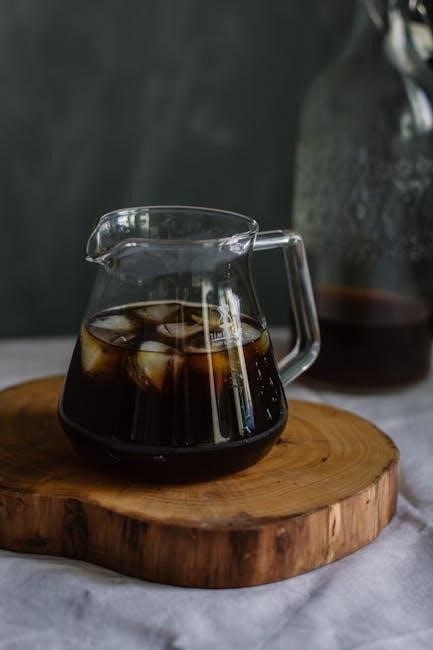
Choosing the Right Equipment
Choosing the right equipment is essential for perfect cold brew. Options include French presses, Mason jars, or dedicated cold brew makers. Consider size, ease of use, and cleanup. A built-in filter and steeping container streamline the process, ensuring flavorful results. Dedicated makers offer convenience and better extraction, making them a popular choice for coffee enthusiasts.
Cold Brew Coffee Makers: Types and Features
Cold brew coffee makers come in various styles, each offering unique features. Glass, plastic, or stainless steel models are common, with built-in filters for easy straining. Some makers include adjustable steeping times, while others have compact designs for convenience. High-end models may feature grinders or multiple chambers for precise extraction. Portable options are great for travel, while large-capacity makers suit households. Key features to consider include ease of cleaning, durability, and compatibility with storage. These designs cater to different preferences, ensuring a smooth and flavorful brewing experience tailored to individual needs.
Additional Tools: Grinder, Scale, and Storage
A grinder ensures freshly ground coffee beans, essential for optimal flavor. A scale helps measure precise coffee-to-water ratios, guaranteeing consistency. Proper storage containers, like glass or stainless steel, preserve the brew’s freshness. These tools enhance the brewing process, ensuring a perfect cup every time.
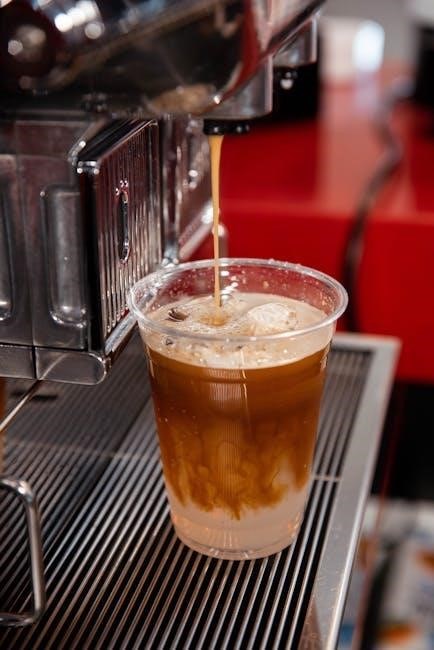
Step-by-Step Brewing Instructions
Start with grinding beans, mix with water, steep for 12-24 hours, then strain. This simple process ensures smooth, full-bodied cold brew coffee every time.
Grinding the Coffee Beans
Start by grinding your coffee beans to a coarse or medium-coarse texture. A burr grinder is ideal, but a spice grinder with short pulses works too. Avoid fine grinds, as they can lead to over-extraction and a bitter taste. Coarse grinding ensures optimal flavor extraction during the steeping process. For the best results, grind the beans just before brewing to preserve freshness and aroma. If using pre-ground coffee, ensure it’s specifically labeled as “coarse grind” for cold brew. Proper grinding is essential for achieving the smooth, balanced flavor cold brew is known for. This step sets the foundation for a perfect brew.
Mixing Coffee Grounds with Water
After grinding, combine the coarse coffee grounds with water in a large container or the cold brew maker’s chamber. Use a 1:4 to 1:8 coffee-to-water ratio for a balanced brew. Stir thoroughly to ensure all grounds are evenly saturated. Use fresh, room-temperature water for optimal extraction. If using a dedicated cold brew maker, place the grounds in the filter or infuser, then add water gradually, stirring gently. Ensure no dry spots remain. Cover the container or seal the maker to prepare for steeping. Proper mixing ensures consistent flavor and prevents under- or over-extraction during the brewing process. This step is crucial for achieving the signature smoothness of cold brew coffee.
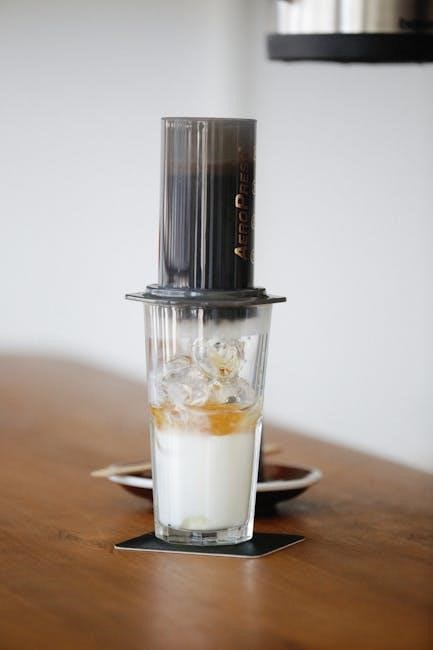
Steeping the Coffee
Once mixed, the coffee grounds and water mixture needs to steep. Place the container or cold brew maker in the refrigerator to steep for 12 to 24 hours. The longer it steeps, the stronger the flavor becomes. Stir the grounds gently halfway through steeping to ensure even extraction. Keep the mixture at refrigerator temperature (around 40°F) to prevent over-extraction and bitterness. Avoid steeping at room temperature, as it can lead to unwanted flavors. After steeping, the coffee is ready to strain and serve. This slow, cold process extracts flavors without the acidity of hot-brewed coffee, resulting in a smooth and refreshing drink;
Straining the Brew
After the steeping process, carefully strain the coffee to separate the grounds from the liquid. If using a cold brew maker, remove the filter or infuser from the container. For other methods, pour the mixture through a fine-mesh sieve or cheesecloth into another container. Ensure no grounds remain in the brew to avoid bitterness. Discard the solids and transfer the strained coffee to a clean glass bottle. Store it in the refrigerator to chill before serving. Proper straining ensures a smooth, flavorful cold brew. This step is crucial for achieving the desired taste and texture. Your cold brew is now ready to enjoy!
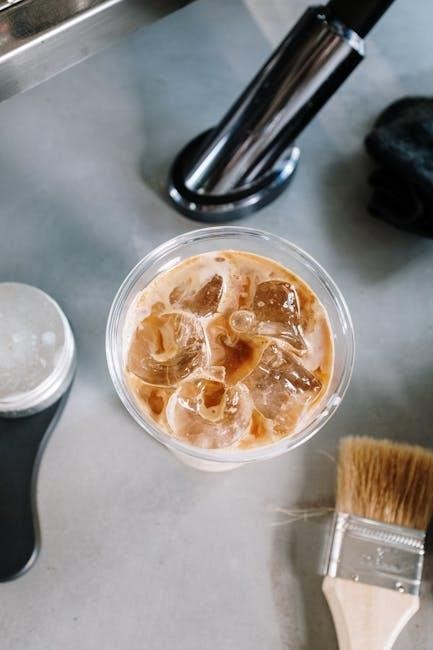
Customizing Your Cold Brew
Personalize your cold brew by adjusting the coffee-to-water ratio, adding flavorings like vanilla or cinnamon, or sweetening with sugar or syrup. Experiment with milk or ice for unique variations.
Adjusting Coffee-to-Water Ratio

Adjusting the coffee-to-water ratio is key to achieving your desired flavor profile in cold brew. A standard ratio is 1:4 to 1:8 (coffee to water by weight). Start with 1:4 for a bold brew or 1:8 for a lighter taste. Experiment by increasing or decreasing coffee for stronger or weaker flavors. Use a scale for precise measurements. For example, 100g of coffee with 400ml water yields a balanced cold brew. If too strong, add water; if too weak, add coffee. Adjusting the ratio allows you to customize the brew to your taste preferences, ensuring each batch is tailored to your liking.
Adding Flavorings and Sweeteners
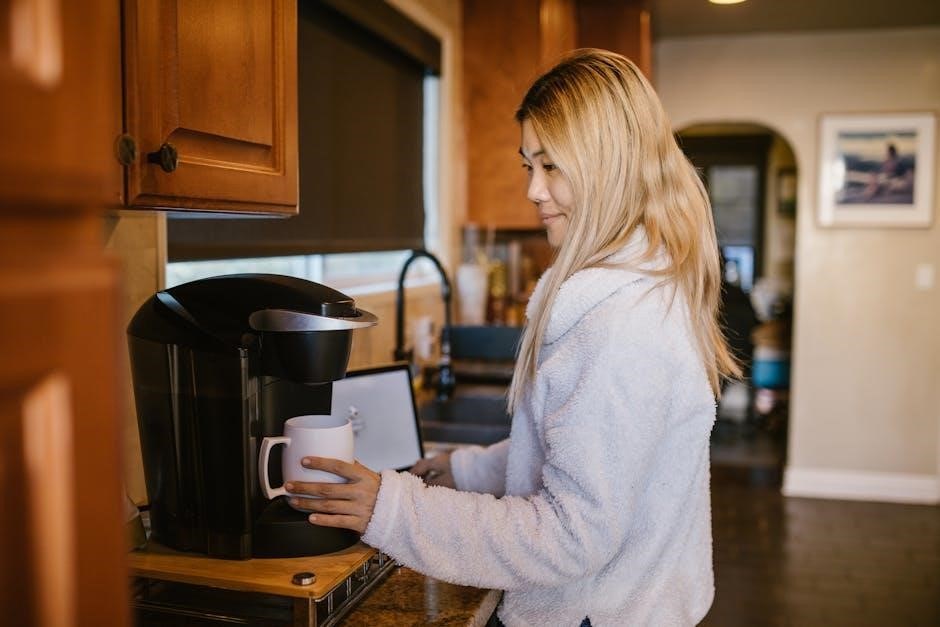
Cold brew coffee can be customized with various flavorings and sweeteners to enhance its taste. Popular additions include vanilla extract, cinnamon, or citrus zest for unique flavor profiles. For sweetness, options like sugar, honey, or syrup can be added after brewing. Milk or creamers can also be incorporated for a creamier texture. Experiment with different combinations to find your perfect blend. When adding flavorings, mix them into the coffee before steeping for even distribution. Sweeteners are best added after straining to ensure they dissolve properly. This step allows you to tailor your cold brew to your taste preferences, making each cup uniquely delicious and personalized.
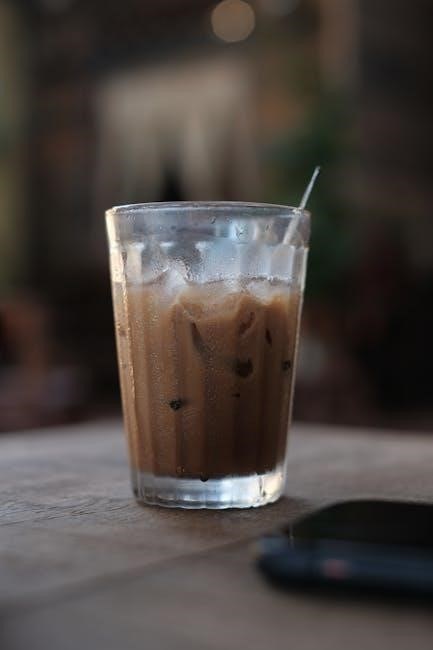
Serving Suggestions: Hot, Iced, or Blended
Cold brew coffee offers versatility in how it’s enjoyed. For a refreshing drink, serve it over ice with water or milk. To enjoy it hot, simply heat the brewed coffee and add your preferred sweeteners or creamers. For a blended treat, combine cold brew with ice, milk, and flavorings like vanilla or chocolate in a blender. You can also customize it further by adding syrups, whipped cream, or spices. Experimenting with these methods allows you to enjoy cold brew in various ways, whether you prefer a classic iced coffee, a warm pick-me-up, or a creamy blended beverage. This versatility makes cold brew a perfect choice for any time of day or season.
Maintenance and Troubleshooting

Regularly clean your cold brew coffee maker to prevent residue buildup. For troubleshooting, check water flow, coffee-to-water ratio, and steeping time to ensure optimal flavor consistency.
Cleaning Your Cold Brew Coffee Maker
Cleaning your cold brew coffee maker is essential for maintaining freshness and preventing residue buildup. Rinse the maker thoroughly with warm water after each use. For deeper cleaning, mix equal parts water and mild dish soap, soak the components for 10-15 minutes, then scrub and rinse. Avoid harsh chemicals or abrasive cleaners, as they may damage materials. Dry all parts completely to prevent moisture buildup. Regular cleaning ensures your cold brew tastes fresh and prevents any lingering flavors from affecting future batches. For tough stains, a vinegar and water solution can be used periodically. Always follow the manufacturer’s care instructions for specific models.
Troubleshooting Common Issues
Common issues with cold brew coffee makers often relate to flavor or functionality. If your brew tastes weak, check the coffee-to-water ratio or steeping time. For stronger coffee, increase the grind quantity or extend the steeping period. Sediment in the brew may indicate improper straining or a damaged filter. Ensure the filter is tightly sealed and replace it if necessary. If water isn’t flowing through the maker, check for blockages in the mesh or tubes. Clean the maker regularly to avoid residue buildup. For slow dripping, ensure the maker is properly assembled. Always refer to the manufacturer’s guide for specific troubleshooting steps. Addressing these issues ensures consistently great-tasting cold brew every time.
Cold brew coffee is a delightful and refreshing beverage that’s perfect for any time of the year. By following the step-by-step instructions and tips provided, you can effortlessly create smooth, flavorful cold brew at home. Experiment with ratios, steeping times, and flavor additions to tailor your brew to your taste preferences; With the right equipment and a little patience, you’ll enjoy high-quality cold brew coffee without the need for expensive cafe visits. Whether you prefer it over ice, mixed with milk, or blended into a refreshing drink, cold brew offers endless possibilities; Happy brewing and enjoy the perfect cup every time!
